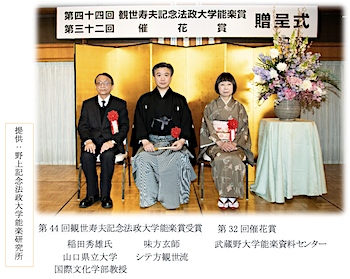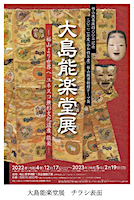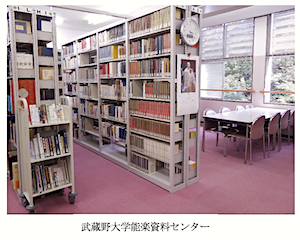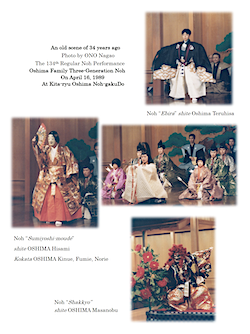NOH OSHIMA BRIEF
The cover stories of our briefs published twice a year or so.
№ 12 cover story April 23, 2023
About the Relationship to Oshima Noh Family for Thirty Years
MIURA Hiroko,
Manager of Noh-gaku Research Laboratory,
Professor of Literature Collge of Musashino University
 Kita-ryu Oshima Noh-gaku Do (Oshima Noh Theater) was awarded the 24th Saika Prize in 2013. This prize is the award by Hosei University to honor those who contribute to the promotion, the prevalence, and the development of Noh-gaku. Hearing about the news, I was very glad that the longtime activities of Oshima Noh-gaku Do were appreciated, and I myself joined the recipient ceremony. About ten years later, in 2022, our Noh-gaku Research Laboratory of Musashino University was also awarded the prize. Having reached the 50th anniversary, but not reaching even the foot of the Oshima Noh-gaku Do, we feel so happy that both of our research and prevailing activities are recognized. And, above all things, it was the most honorable occasion that Mr OSHIMA Teruhisa of Oshima Noh Family was at our recipient ceremony.
Kita-ryu Oshima Noh-gaku Do (Oshima Noh Theater) was awarded the 24th Saika Prize in 2013. This prize is the award by Hosei University to honor those who contribute to the promotion, the prevalence, and the development of Noh-gaku. Hearing about the news, I was very glad that the longtime activities of Oshima Noh-gaku Do were appreciated, and I myself joined the recipient ceremony. About ten years later, in 2022, our Noh-gaku Research Laboratory of Musashino University was also awarded the prize. Having reached the 50th anniversary, but not reaching even the foot of the Oshima Noh-gaku Do, we feel so happy that both of our research and prevailing activities are recognized. And, above all things, it was the most honorable occasion that Mr OSHIMA Teruhisa of Oshima Noh Family was at our recipient ceremony.
The relationship between Oshima Family and I is rather long. It began at OSHIMA Kinue-san's entrance to the Music College of Tokyo University of the Arts in 1993, just thirty years ago.
Yokyoku Club is in Tokyo Art Uni, where utai of Kita-ryu is traditionally practiced eagerly. Though studying in the Music College, I belonged to the club and was taught by Mr OMURA Sadamu when I was in the Master Course of the college, and kept practicing after getting an MA. Soon Kinue-san joined the club and we practiced together, including ji-utai of the student Noh "Tomoe." Later OSHIMA Norie-san entered the University and also joined the club. I remember we had a nice time lodging for practicing all together on Sado Island.
In 1987, I served in a reader position at Musashino Women's College, which is now Musashino University. Before long, OSHIMA Fumie-san entered the college and joined the Noh-gaku Research Club, where Mr SHIOTSU Akio was an instructor. One day in those days, while Kinue-san was working part time at our laboratory, Fumie-san came up and said to her, "I forgot my purse today." "Well, I myself don't have so much with me," said Kinue-san but gave her some reluctantly. I clearly remember the scene, for I happened to see Kinue-san's another fresh aspect as the eldest daughter.
Because of this and that, I came to watch Kinue-san's Noh performances, including the shimai at Toka-Gakudo in the East Garden of the Imperial Palace, which only a few of the most outstanding graduates are given the honor to perform. I also had a precious occasion then to write some explanation on the pamphlet about the stage.
As for her graduation, Kinue-san performed the Noh piece "Kakitsubata" at Yokohama Noh-gaku Do, built newly in 1996, to commemorate her finishing college. Maybe she played as the extra at the Amateur Meet of Oshima Family. I saw an amazing scene there. Mr OSHIMA Hisami, who should serve as koken and sit at the back part on the stage, was taking pictures here and there, by the curtain, at the front, and at the back of the audience. We could not help but gaze at the innocent grandfather, whom we thought to be strict about the art.
Hisami-sensei was known to worship the 14th Kita Roppeita. So, I intended to interview him about the legend when I was young. My colleague and I planned to visit Fukuyama, but just before starting she got sick, and I only came to Fukuyama to meet him. I thought I did not need to tell that I came alone, but it was my failure. On seeing me, OSHIMA Yasuko-san looled so disappointed because boiled eel lunch was prepared for two of us. I was not able to find any word of apology. She was going to welcome a rookie like me as a respectable person. (And the eel lunch was very delicious, I remember.)
About Oshima Family, all of you know much more than I. They are full of dutifulness, consideration, but also generosity. That is the family tradition. Several years ago when I came to Fukuyama to do the explanation of the Regular Performance, they invited me to a nice dinner in the previous evening. After finishing the dinner, they arranged a taxi for me. The family member said that the host, OSHIMA Masanobu-sensei, would go home by his own car, which was waiting for him in the backyard of the restaurant. It turned out to be his bicycle. His frankness must have produced the family nature.
 The other day, I went to the Oshima Noh-gaku Do Exhibition at Fukuyama Castle. A lot of local spectators were there to appreciate the splendid treasures. There is a saying: 'it is darkest beneath the lamp.' The event has become a good chance in a sense. I could realize how the Oshima Family have devoted themselves to the exhibition, as usual. Wonderful Noh masks, costumes, and other material are liberally exhibited, and above all, I was fascinated by the design and color pattern of sewed foil (cherry blossoms on the dark-blue ground with mist pattern) and long silk (downward fan on the purple ground with wisteria pattern) the most. I found these two shown on the back of the exhibition leaflet. They must be the finest costumes of Oshima Family, and I have confirmed that the family has strived to collect high-quality goods as an art.
The other day, I went to the Oshima Noh-gaku Do Exhibition at Fukuyama Castle. A lot of local spectators were there to appreciate the splendid treasures. There is a saying: 'it is darkest beneath the lamp.' The event has become a good chance in a sense. I could realize how the Oshima Family have devoted themselves to the exhibition, as usual. Wonderful Noh masks, costumes, and other material are liberally exhibited, and above all, I was fascinated by the design and color pattern of sewed foil (cherry blossoms on the dark-blue ground with mist pattern) and long silk (downward fan on the purple ground with wisteria pattern) the most. I found these two shown on the back of the exhibition leaflet. They must be the finest costumes of Oshima Family, and I have confirmed that the family has strived to collect high-quality goods as an art.
At the same time, I realize the luxury to appreciate the Noh performances at Oshima Noh stages. To see the graceful women behaving devotedly at the reception desk is an excessive delight, and the delicious taste of the waffle at Kakinoki-bana is still another.
I was taught in college that one generation is a unit of thirty years in English. Kaoruko-san, the daughter of Teruhisa-san, is at the age of entering college; Iori-san, his son, is performing the Noh piece "Makura Jidou" at the Shinnoh of Toka-sai of Itsukushima Shrine this year. The relationship to Oshima Family tied by Kinue-san began just thirty years ago. I do really recognize the beginning of a new fresh generation.
 My main research field is the music and history of Noh and Kyogen. I am often impressed by the actors, who once served to the rural Clans, devoting themselves to the recovery of Noh and Kyogen during the disturbance period of the Meiji Restoration. In the waves of the aging and the declining birth rate, the situation about the Nohgaku is quite difficult. I think, just like in the Meiji period, it is the rural power that saves Noh and Kyogen.
My main research field is the music and history of Noh and Kyogen. I am often impressed by the actors, who once served to the rural Clans, devoting themselves to the recovery of Noh and Kyogen during the disturbance period of the Meiji Restoration. In the waves of the aging and the declining birth rate, the situation about the Nohgaku is quite difficult. I think, just like in the Meiji period, it is the rural power that saves Noh and Kyogen.
And I am confident that Oshima Family play a more and more important role even from now on. As for me, in the long course of my life with Noh, I have found new things every time I watch the performances. Hisami-sensei once said, "Noh should be pleasant," when I interviewed him. The phrase impressed me, even now. To talk about the pleasure I find out would be my valuable job.
№ 11 cover story January 26, 2023
Welcome to our Three-Generation Noh
OSHIMA Teruhisa, Kita-ryu Shokubun
We thank to you all for coming to the Oshima Family Three-Generation Noh today. It is the second time for Oshima Family that the three performers in the same direct descent play shite in one program.
The last and first one was held in 1989, 34 years ago. That was when I played "Ebira" for my first time performing Noh at the age of thirteen. My grandfather Hisami had me practice strenuously for one whole year. I remember vividly the extraordinary exaltation after finishing the performance.
In June of the year before last, my father Masanobu played "Shunzei-Tadanori," saying "This would be my last." But several days after he finished that stage gracefully and all of us felt at ease, he uttered during a daily conversation of our family, "I feel lonely and a bit incomplete that Shunzei-Tadanori was at the end of my career." His words have caught me since then and I have made up my mind to adorn his conclusively final stage dignifiedly. Wondering which program to direct for my father, I came up with the old Three-Generation Noh more than thirty years ago. Yes, now is the time we can do that, and here we are.
 Today, on the first stage, my son Iori plays "Ebira," which I myself did last time.
My father plays "Saigyo-zakura," which his father, my grandfather, did at that time.
On the last stage, my sister Kinue and I play "Ninin-midare" in an uncommon version 'Tsubodashi.'
Today, on the first stage, my son Iori plays "Ebira," which I myself did last time.
My father plays "Saigyo-zakura," which his father, my grandfather, did at that time.
On the last stage, my sister Kinue and I play "Ninin-midare" in an uncommon version 'Tsubodashi.'
And as for Kyogen, Mr YAMAMOTO Tojiro, a living national treasure, with his company performs the famous "Hagi Daimyo," which made our stages more splendid and profound.
It may be rare to be able to play a three-generation Noh twice, from my grandfather down to my son. And this occasion is under various kinds of your support. We thank all of you heartily.
